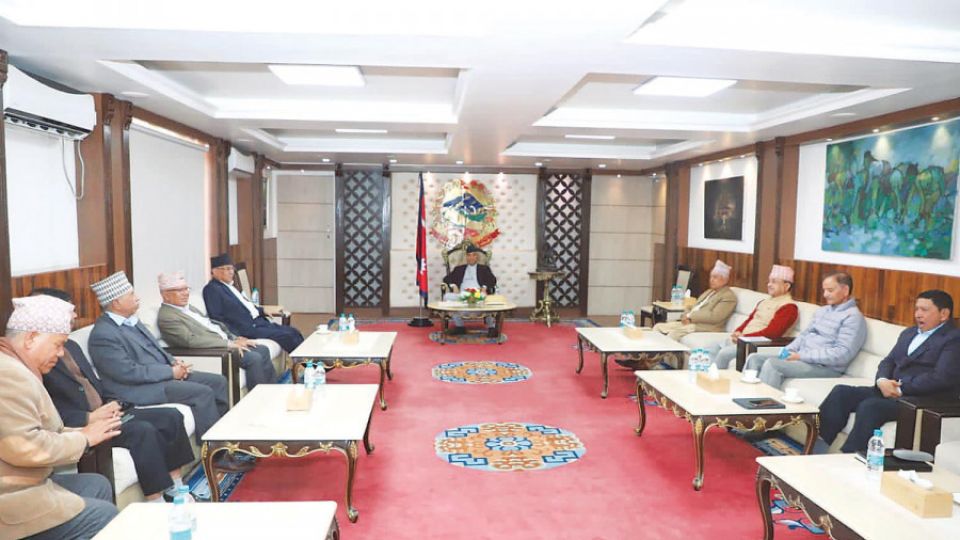December 8, 2022
KATHMANDU – The CPN-UML, which trailed the ruling Nepali Congress in the first-past-the-post (FPTP) seats, has won the most (34) seats of the lower house under the proportional representation (PR) system.
In the seat allocation completed on Tuesday night, the ruling Congress has managed to bag 32 PR seats. The party that had won 57 FPTP seats will now have a total strength of 89 seats in the House of Representatives, to become the largest party.
The UML, with 78 seats (including 44 from the FPTP) will have a presence in parliament as the second largest party.
Some 61 percent of the 17.98 million registered voters cast their ballots in the single-phase parliamentary and provincial elections on November 20. As per the commission’s report, the number of valid PR votes was 10.05 million.
Of this total, the UML collected 2.84 million PR votes. The Congress was hot on its heels with 2.71 million PR votes, followed by the CPN (Maoist Centre) and the Rastriya Swatantra Party, which collected 1.17 million and 1.13 million votes, respectively.
The Maoist Centre, which won 18 seats under the FPTP system, has managed to secure 14 more seats under the PR system, to have a total of 32 representatives in the lower house. With 13 seats under the PR, the Rastriya Swatantra Party takes hold of the fourth position with a total of 20 seats including seven FPTP seats.
Out of the 68 parties registered for the election under the PR system only seven could meet the threshold of three percent votes needed to qualify for parliament seats under the PR category. The Rastriya Prajatantra Party, the Janata Samajbadi Party and the Janamat Party are other three parties which have met the threshold.
Despite winning 10 seats under the FPTP system, the CPN (Unified Socialist) couldn’t cross the threshold.
Based on the vote share, the commission had allocated the 110 PR seats of parliament among the eligible parties. “We have apportioned the seats based on the vote share of the seven parties crossing the threshold,” Dinesh Thapaliya, the chief election commissioner, told the Post.

Total seats won by parties. Post Graphics
As per the seat allocation, the pro-Hindu and pro-monarchy Rastriya Prajatantra Party party won seven seats under the PR category, to equal its seat tally under the FPTP category. The Janata Samajbadi Party that had registered victory in seven seats under the direct elections has got five seats under the PR system.
The CK Raut-led Janamat Party that crossed the threshold to become a national party in its first foray into parliamentary elections also has got five seats, bringing it on level terms with the Janata Samajbadi Party. (Janamat Party had won one FPTP seat.)
In this way, the five-party ruling alliance has secured 136 seats against 138 required to prove a majority in the 275-strong House. The alliance includes the Congress, the CPN (Maoist Centre), the CPN (Unified Socialist), the Loktantrik Samajbadi Party, and the Rastriya Janamorcha, which have won 89, 32, 10, four and one seats, respectively.
“The commission on Wednesday will ask the parties to name lawmakers under the PR category,” Surya Aryal, assistant spokesperson at the commission, told the Post. “The parties will have to send the names from the closed lists they had earlier submitted to the commission.”
The seven parties will get three days to send the names to the commission. If their list doesn’t have proper representation of various clusters of caste groups and communities, they will get one more day to make corrections. “We will submit the final report to the President when the names under the proportional representation are finalised,” said Aryal, adding the report is likely to be presented on December 12 or the next day.
Submission of the final report will clear the way for the parties to form government and commence the new parliament. After receiving election results from the commission, President Bidya Devi Bhandari will invite parties to form a government within two days. As no party commands a majority, she will call for a coalition government as per Article 76 (2) of the Constitution of Nepal.
Similarly, the process to summon the first meeting of the House of Representation will begin following the submission of the election results to the President. As per Article 93 (1) of the constitution, the President summons a new session of the federal parliament within 30 days of the declaration of final results.
If the final results are submitted on December 12, the first meeting of parliament must start latest by January 11. “Our preparations for the first meeting of the lower house are in full swing. We have already arranged office spaces for the new parties that were not represented in the previous Parliament,” Roj Nath Pandey, spokesperson at the parliament secretariat, told the Post.
The selection process for the Speaker and Deputy Speaker of the House of Representatives will also start with its first meeting as per Article 91 (1) of the constitution. “The members of the House of Representatives shall, within 15 days of the date of holding of the first meeting of the House of Representatives, elect a Speaker and a Deputy Speaker from amongst themselves,” reads the Article.


